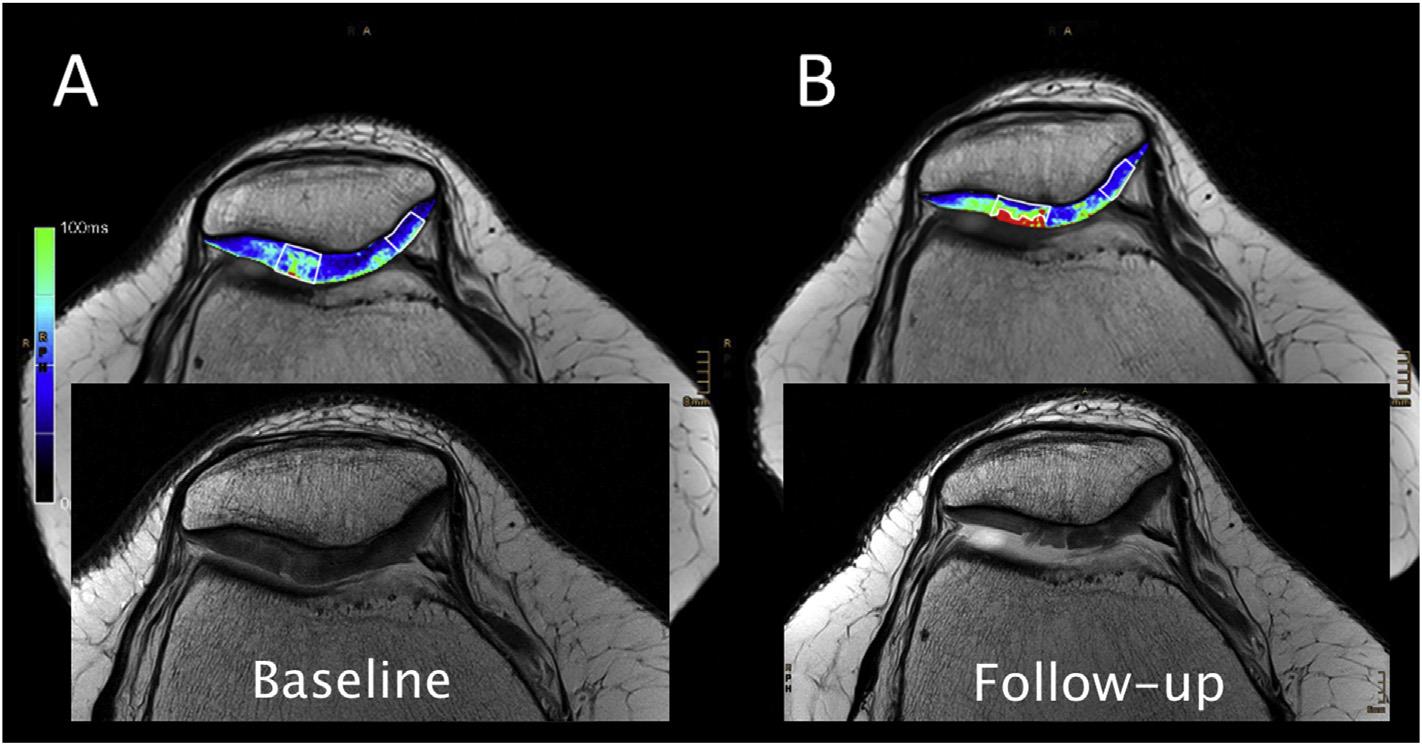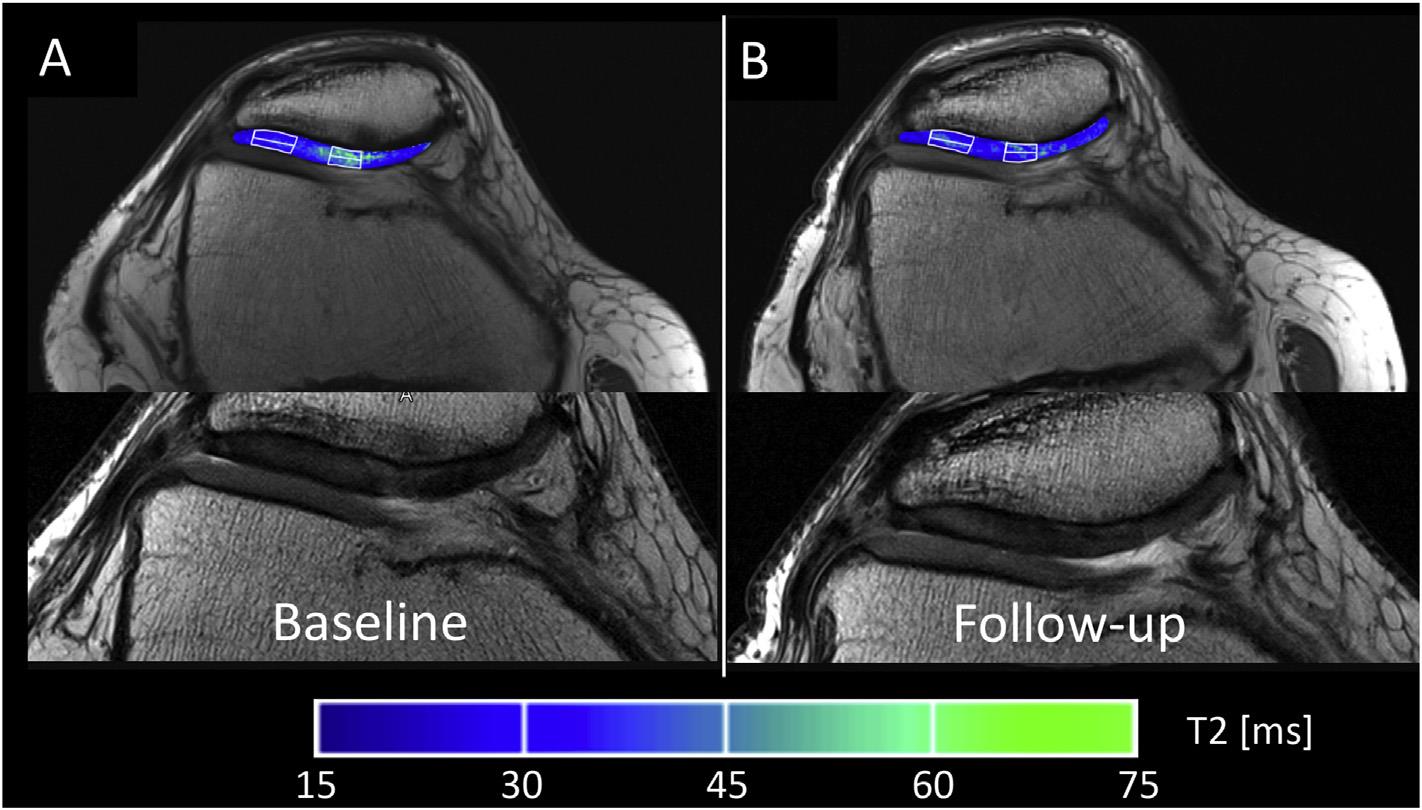Application of gadolinium-based contrast agents in magnetic resonance imaging methods, prediction for patients with untreated patellar cartilage lesions
Investigator: Szomolányi, P.
Many factors influence the increase in signal intensity provided by magnetic resonance imaging (MRI) contrast media. Purpose: To assess the impact of different gadolinium concentrations and dilutions of three macrocyclic gadolinium-based contrast agents. The test tubes were positioned in a rack in a silicon oil bath to maintain the temperature at 370C during the measurement. Silicon oil temperature was kept constant using warm water, which flushed a separate chamber within the tube holder. The water flushed chamber was separated from the bath oil by a thin thermal-conductive wall.
The research was oriented to demonstration of the potential of axial T2 mapping for quantification of untreated early-stage patellar cartilage lesions over time and to assess its capability as a potential predictive marker for future progression. This mapping sequence, in combination with the unique characteristics of the patella cartilage (thick cartilage, superficial and parallel position to the body surface) might be well suited for future prospective studies to evaluate the natural course of cartilage defects and their treatment in vivo (Fig.1).
Fig. 1: 34-year-old female patient with an ICRS grade 1 cartilage defect. After 3 ½ years, the morphological follow-up image showed a progression of the cartilage defect. The corresponding T2 map shows a significant increase (red area of cartilage).
Fig. 2: 42-year old male patient with suspected cartilage lesion. After 4 years, morphological cartilage status seems to have improved, as well as T2 values have decreased (green colored cartilage turns to blue).
Project: APVV-15-0029
Foreign partner: Univ.-Prof. Dr. Siegfried Trattnig, , High Field MR Center, Department of Biomedical Imaging and Image-guided Therapy, Medical University of Vienna, Austria.
Signed agreement on scientific cooperation by 31. XII. 2020.
Publications 2020:
- SZOMOLÁNYI, Pavol – FRENZEL, T. – NOEBAUER-HUHMANN, I.M. – ROHRER, M. – TRATTNIG, S. – PIETSCH, H. – ENDRIKAT, J. Impact of concentration and dilution of three macrocyclic gadolinium-based contrast agents on MRI signal intensity at 1.5T and 3T and different pulse sequences: Results of a phantom study in human plasma. In Acta Radiologica, 2020, ISSN 0284-1851. (1.635-IF2019) Q2
- EDER, J. – SZOMOLÁNYI, Pavol – SCHMID-SCHWAP, M. – BRISTELA, M. –SKOLKA, A. – PITTSCHIELER, E. – PIEHSLINGER, E. – TRATTNIG, S. Early diagnosis of degenerative changes in the articular/fibrocartilaginous disc of the temporomandibular joint in patients with temporomandibular disorders using delayed gadolinium-enhanced MRI at 3 Tesla – preliminary results. In Magnetic Resonance Imaging, 2020, vol. 67, p. 24-27. ISSN 0730-725X. (2.053-IF2019) Q2
- APPRICH, S.R. – SCHREINER, M.M. – SZOMOLÁNYI, Pavol – WELSCH, G.H. – KOLLER, U.K. – WEBER, M. – WINDHAGER, R. – TRATTNIG, S. Potential predictive value of axial T2 mapping at 3 Tesla MRI in patients with untreated patellar cartilage defects over a mean follow-up of four years. In Osteoarthritis and Cartilage, 2020, vol. 28, no. 2, p. 215-222. ISSN 1063-4584. (4.793-IF2019). https://doi.org/10.1016/j.joca.2019.10.009. Q1
- ZBÝŇ, Š. – SCHREINER, M. – JURÁŠ, Vladimír – MLYNARIK, V. – SZOMOLÁNYI, Pavol – LAURENT, D. – SCOTTI, C. – HABER, H. – DELIGIANNI, X. – BIERI, O. – NIEMINEN, M.T. – TRATTNIG, S. Assessment of low-grade focal cartilage lesions in the knee with sodium MRI at 7 T: Reproducibility and short-term, 6-month follow-up data. In Investigative Radiology, 2020, vol. 55, no. 7, p. 430-437. ISSN 0020-9996. (5.156-IF2019). https://doi.org/10.1097/rli.0000000000000652. Q1
 Contacts
Contacts Intranet
Intranet SK
SK

